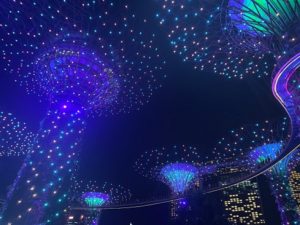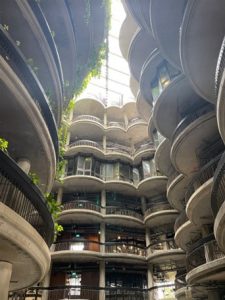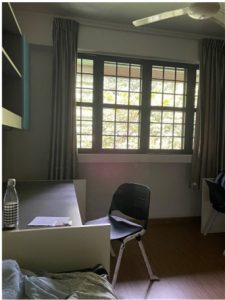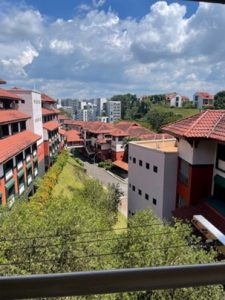Student at the Faculty of Science

My exchange semester in Singapore was one of the most unique experiences I have had in my life. It opened my eyes to a different part of the world and gave me an unforgettable experience.
Arriving in Singapore and first impressions
I got confirmation of getting into this exchange programme just a month before it would start. Therefore I arrived in Singapore at the beginning of January, just after New Year’s ended here in Finland. I arrived just a day before orientation as flights to Singapore can get quite expensive around the new year. There was one main orientation event on Friday of that week where they gave instructions and told us about the University itself. There was additionally a short tour around the main campus area. However, I got to know the campus area and its best spots by exploring myself during the first few weeks.

My first few impressions of the country were that it was very warm and humid. It was something that I wasn’t used to before. Having it be 30 degrees every day was a bit of a shock after leaving Finland during the winter. Another thing that I was hit by was jet lag. It was especially bad during the first few days but I got used to it fairly quickly. Singapore is culturally very different and has many cultures integrated into one. The country was generally very clean and the streets were well taken care of. The campus area was huge and very green. It was something I had never seen before. I feel like in the beginning Singapore felt like its own world with all the high buildings and how technologically advanced it was.
The first few weeks were generally me getting to know my campus area and seeing some tourist sights. I do recommend having some Singaporean dollars before you arrive in Singapore as I had to pay my prepaid sim card with cash at the airport. Additionally, during these weeks all the visa matters were sorted at the university. Something you needed to fill out before coming to Singapore was the IPA (in principle approval letter). This would allow you to pass through the automated gates without any problems.
Daily life
I got used to daily life quite quickly as I arrived just before the teaching period started. Studying started almost immediately with weekly assignments and reading to do. So getting used to the teaching pace wasn’t too difficult. The food culture in Singapore and on campus was very heavy on food courts. These would have different stalls that you could order from. Mainly Chinese, Indian, Thai, Japanese, Korean, Malay etc. There would occasionally be more Western food stall. Eating at these food stalls would become part of your daily life as it is cheaper to eat at these than other restaurants and cooking wasn’t an option as an exchange student. You could, however, heat meals or make instant ramen. So it is generally recommended to eat at these food stalls. A meal would vary from 4 to 9 dollars on campus. It would also be cheaper to eat on campus than outside.
One difficulty I had during my exchange was finding vegetarian food. In Singapore, a lot of the foods would be very heavy on meat and chicken options. There would be a few vegetarian options and if you eat fish then it’s less of a problem. However, being completely vegan is almost impossible. Another adjustment I had to get used to is not having a fridge. The hall rooms weren’t equipped with fridges or pantries. Me and my roommate decided to not take a fridge as it would have cost and you would have had to pay the university a fridge fee due to it being considered a big electrical appliance. So in the beginning it was a bit difficult but it’s manageable.
Housing

During my exchange period, I lived in the dorms which are called halls that were scattered around the main campus area. The campus of NTU was really impressive as it reminded me of a small city/ village just outside the main road. In the hall, I lived with a roommate. When applying to NTU you can choose between having a single room or a double room. Single meaning having a room to yourself and double meaning having a roommate. However, it was notified beforehand that single rooms were only subject to availability. The room I was in was equipped with the most basic necessities being a bed, a closet, a desk and some storage area. The room also had a fan and aircon. During the exchange period, the fan becomes your best friend as in the first few months of my exchange me and my roommate couldn’t use the aircon. This was due to not having a local card to top up the payment for using the aircon. Later on, the university made it possible to use a phone application to pay as well as control the machine.

The halls were also equipped with shared bathrooms, a laundry room and a pantry that had a microwave, a stovetop and hot/cold water. The laundry room had a few machines and one dryer. Every block would have two laundry rooms. (the halls are divided into around 4 blocks) For the machines, you had to pay with the new 3rd generation 1 dollar coin. Getting these coins would be a bit difficult, however, some of the student representatives of the blocks would arrange money exchanges. Or you can also exchange bills for these coins in laundromats, which I would usually do. I would also recommend drying your clothes in the dryers as Singapore is very humid which makes drying clothes more difficult and prone to getting mould.
Semester length and holidays

The semester was broken up into two parts. From January to the end of February and then from the beginning of March until the midpoint of April. This was divided by a week. This week was called recess week. It generally is for studying or looking into content that starts after this week. However, for many students and exchange students, this week was more of a travel week. I knew a lot of students that went travelling to either south-east Asia or other parts of Asia. During this time I went to Japan where I visited Tokyo and Kyoto. I chose to visit Japan because it was a long-time goal and a country where I wanted to travel to. There were still a few other national holiday days during the semester which included the Chinese new year which in total was 4 days.
Even though the semester was divided by a week the contents of the courses were still connected in contents. A few of my courses did change professors after this halfway point. In April started a so-called reading period. This lasted two weeks until the exams started at the beginning of May. Some exchange students went on more travelling during those two weeks but I stayed at campus to study for the final exams.
Courses, teaching and exams
I took 6 courses in total during my exchange period which were then in total 15 AU (credit system used in Singapore). Which added up to 30 credits at Helsinki University. I took 3 courses that were directly related to chemistry as that is what I’m studying in Helsinki. These 3 courses had a larger content pack than what I was used to at my home university as we have 4 periods which break the content. I also took 3 other courses that were a bit easier so that I wouldn’t have too heavy workload during this semester. These were a language, an ethics course and a forensic science course. The latter course was my favourite course during my exchange as it was really interesting. The forensic science and ethics courses were conducted in an online environment. The rest of my courses were held on campus. So this would mean that they were lecture based with an occasional tutorial class period. Meaning that it could have a tutorial class in the first half of the semester of the second.
At NTU some courses would have midterms just before the recess week would start meaning that you would have an exam based on the contents that you studied during the first half of the semester. This would be part of the continuous assessment. My language course had 2 oral examinations and a written/reading assessment. The two online courses didn’t have a final. The ethics course had weekly content and a final written assessment and peer review. The forensic science course had 2 case studies and peer reviews based on other works. This course also had weekly online lecture-type videos. The final examination period was conducted at the very end of April and the beginning of May. Most exams would, however, end on the 5th of May already. The final exams would have content based on the first half of the semester and the second half. I had two final exams from two of my chemistry courses. The exam situation reminded me of the finals that we would have during high school in Finland. However, these exams are conducted on paper and would be from 1 hour to 2 hours. In Singapore the grading system was with letters, the best being an A+ which represents a 5 at our university.
Generally, I found the workload to be a bit more than at Helsinki, however, assignments during the week were about the same. The biggest difference was that for one exam you would read content from 14 weeks (the number of teaching weeks) and not the 6-7 as in Helsinki. The courses were similar in style to what we have being that there are lecture slides which are based on book material. These would be given to us in the NTU online environment which was called ntulearn. This is very similar to our Moodle environment and easy to use. Courses were chosen in a Stars environment and these would be subject to availability. You would also have to choose the course based on time and which fits the schedule. In general, you were not allowed to take overlapping courses or if exams would overlap. So in the beginning I had to be very careful that my courses wouldn’t overlap with each other. Additionally, as an exchange student, it made me a bit sad that I couldn’t take any lab courses.
In Singapore, the studying culture is very rigorous. Meaning that studying is taken very seriously. People do a lot of studying and then their free time would be used for various sports or other hobbies. At our university, there were a lot of different clubs. The most common ones were something related to sports. Also, a lot of halls would have their own sports clubs and they would then compete against each other. My hall had various sports clubs and also a music club. I also know that some other exchange students did dancing. There were also some events like cooking and arts and crafts which you could apply to. I joined one of these and it was a very nice change to the studying period. Additionally, alcohol isn’t a big part of student life except for some events. A lot of the exchange students were surprised by this and thought alcohol was quite expensive. However, I feel like it is pretty similar in price range to Finland.
Student life and events

Exchange students also did arrange some of their own events during the semester. These included going to some clubs, outings, or just hanging out. During the first week, I went with a few exchange students to Lazarus Island which is a bit smaller and harder to get to than Sentosa Island which is connected to Singapore island by public transportation. We went there during the morning and rented a boat that would take us there. The same boat would get us in the evening at around ten. I recommend visiting this island as it is different to Singapore. It was a lot calmer and rich in nature. Additionally, the ocean water was very warm due to it being 30 degrees mainly. This surprised me coming from Finland.
Most of the exchange student events were organized by the students themselves. This would be done via a WhatsApp group that was made at the beginning of the semester. There were a few events organized by the university as well. These were for example, in the beginning, to get to know some of the exchange students, an event for Chinese new year to get to know how it is celebrated in Singapore (you also got a mandarin and red envelope) and an end of the semester “good-bye” event. It was also possible to join some of the events arranged by the halls. For example, my hall which was hall 9 had some events like a food drive for acai bowls and they also provided snacks to get through the reading period for finals. The hall also arranged some board game nights and sports events. Hall 9 was also big on cycling so if you’d wanted you could have joined a cycling event across the country which I found to be an interesting concept. Most of these events were announced on hall-specific telegram groups or Instagram. For main student events, we would get emails and sign-up information.
What surprised me the most
In Singapore, students are similar to Finnish students being more reserved and to themselves. This point was made by my professor. Singaporeans are also mainly in their friend groups. Another thing that surprised me was that water is drinkable from taps but not that cold. You can However find cold water from water tanks and fountains scattered around in halls and on campus. So I recommend having a water bottle.
Singapore also has many weird laws such as; no chewing gum and not eating on public transportation. These two things are part of what I was used to living in Finland but a big no-no in Singapore as you can get fined for it.
In the very beginning masks were also something you had to use. So coming from Finland where we haven’t used them for a while it was something to get used to again. You weren’t allowed on public transportation if you didn’t wear one. However, this was changed a few months in with the decrease in covid cases.
During this exchange, I also learned a lot of Singaporean history and culture that I wasn’t aware of before arriving.
Return to Finland
The last week of being in Singapore was really weird for me. This is it? was a question that was repeated many times during this week. I felt like at times it went by a bit slow but overall the 5 months went by in a blink of an eye. This experience helped me grow as a person and become more open-minded. This is something I recommend anyone to have as an exchange student. This truly was an unforgettable experience and I met some amazing people.
Returning to Finland hadn’t hit me yet. This is because I and many other exchange students still decided to travel around as Singapore is a hub for travelling around Asia. I still personally visited Malaysia and South Korea with a friend for a few weeks. However, my return flight was from Singapore.

The last day in Singapore then finally hit me and returning to Finland felt weird. This is because I had now lived 5 months in Asia and returning to Finland felt odd. Additionally, the reverse culture shock was a thing a lot of people mentioned when returning home. I can say this hit me as well. A funny thing that also happened was that I lost the concept of time when I arrived in Finland. However, overall it was nice to return home where it is a bit calmer and you can catch a break from the big city life. As it isn’t as hectic to live in Helsinki as in Singapore. Looking back this was a one-of-a-kind experience which I am thankful for having had.
Some things to take into consideration
- Apply on time – This helps with the stress of applying and getting everything done before the exchange semester begins. I only had a few months as applied to filler spots. So this is to get everything done so I recommend starting early. Also, remember all the deadlines for important documents and course registration.
- Check for vaccinations – Before I got to Singapore I had to get the yellow fever vaccination and hepatitis B vaccination was recommended. Additionally, you had to have all three doses for covid-19 (this might change however in the future)
- Clothing- Take clothes that you can use in summer conditions. You don’t need warm clothes as the climate doesn’t change from humid and 30 degrees.
- Climate – Be prepared for the heat and humidity
- Sunscreen – Buy sunscreen from Finland as it might be expensive in Singapore and a bit harder to get.
- Fan – The fan in your room is your best friend as aircon is not guaranteed in all rooms. Some exchange students didn’t have aircon in their rooms.
- Mold – This is something I experienced while in Singapore so I’d suggest being wary of this problem.
- Grab – Download the Grab app. It is very useful for getting food and taxis. This is useful as public transportation doesn’t run after midnight so if you need transportation this is your best bet. This app is also useful in Southeast Asian countries.
- Mrt – THis is the local metro line. You can buy a card for it but Finnish Mastercard works as well. I used it and found that the price was still okay regardless of the change rate. It was monthly a bit cheaper than what I would pay for HSL.
- Laws – Remember to read the laws of Singapore as they can be quite strict but it is generally fine and not a dangerous country. You’ll be fine with general knowledge.
- Language courses – Take a language course as it’s very interactive and you get to know some locals. I met some of the funniest people through this course.
- Travelling – Travel outside Singapore as well. Singapore is an amazing hub to get around Asia and I recommend doing that as well. This made my experience a whole lot more valuable and culturally rich.
Lastly, I want to wish you luck on applying and I do recommend Singapore as an exchange country.
